Famiglia : Fagaceae

Text © Prof. Paolo Grossoni

English translation by Mario Beltramini
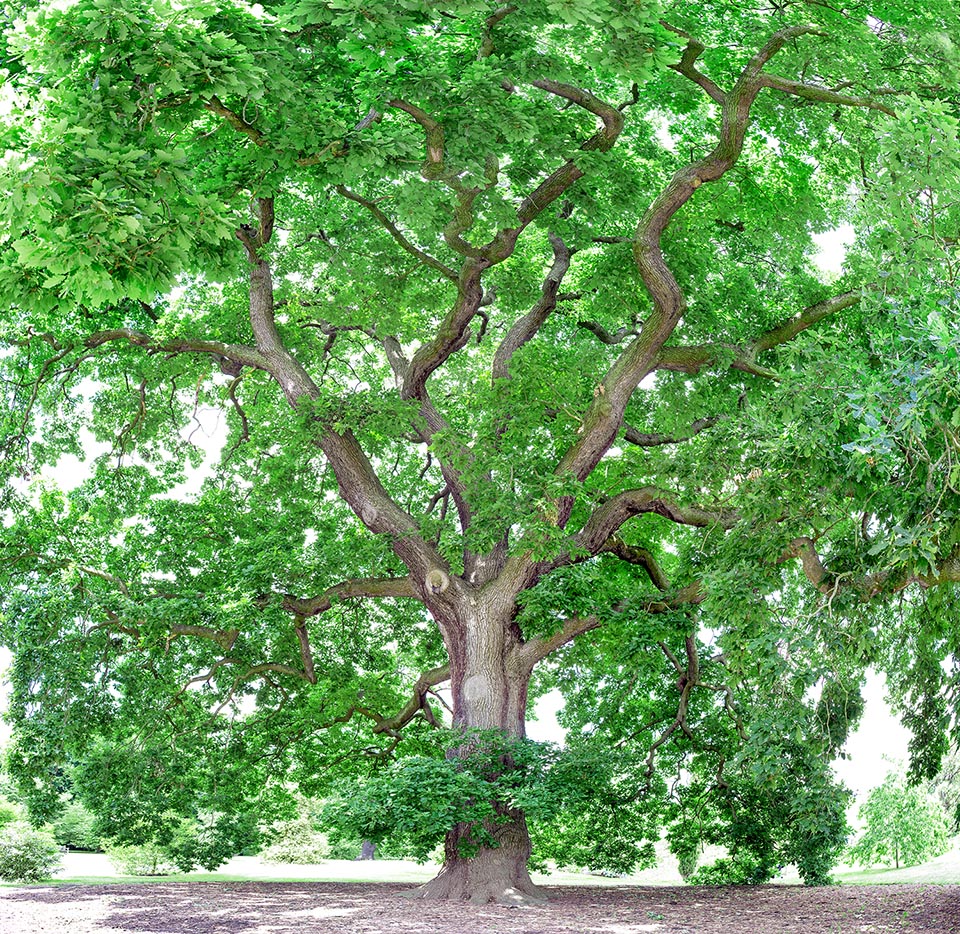
For size, age and their central role in the forest’s life, oaks have always aroused awe and reverence in ancient European populations © Giuseppe Mazza
The Sessile oak (in Italian, “il rovere” – male name as suggested by the Accademia della Crusca Dictionary, even if the female name “la rovere” is certainly more commonly used) is one of the several oaks belonging to the genus Quercus L.
The systematics of the genus is very complex and discussed but the most recent researches attribute to it about 400 species (423 after Denk and collaborators; 2017). There are oaks having leaves with an entire margin and others with lobate leaves, and, among the latter ones, species with rounded lobes and species with acute lobes, there are evergreen oaks, deciduous ones and, also, oaks with semi persistent foliage. The morphological characters that allow more immediately to recognize quickly an oak are the fruit (the “acorn”), that is a single nut always partially inserted in a hemispherical cupule covered by scales usually appressed and decurrent, and the buds that in the apical part of the twig are grouped and that are clearly visible during the winter season. The chromosome number is the same for all species (2n = 24).
The oaks are native of the temperate as well as in the subtropical regions of the northern hemisphere.
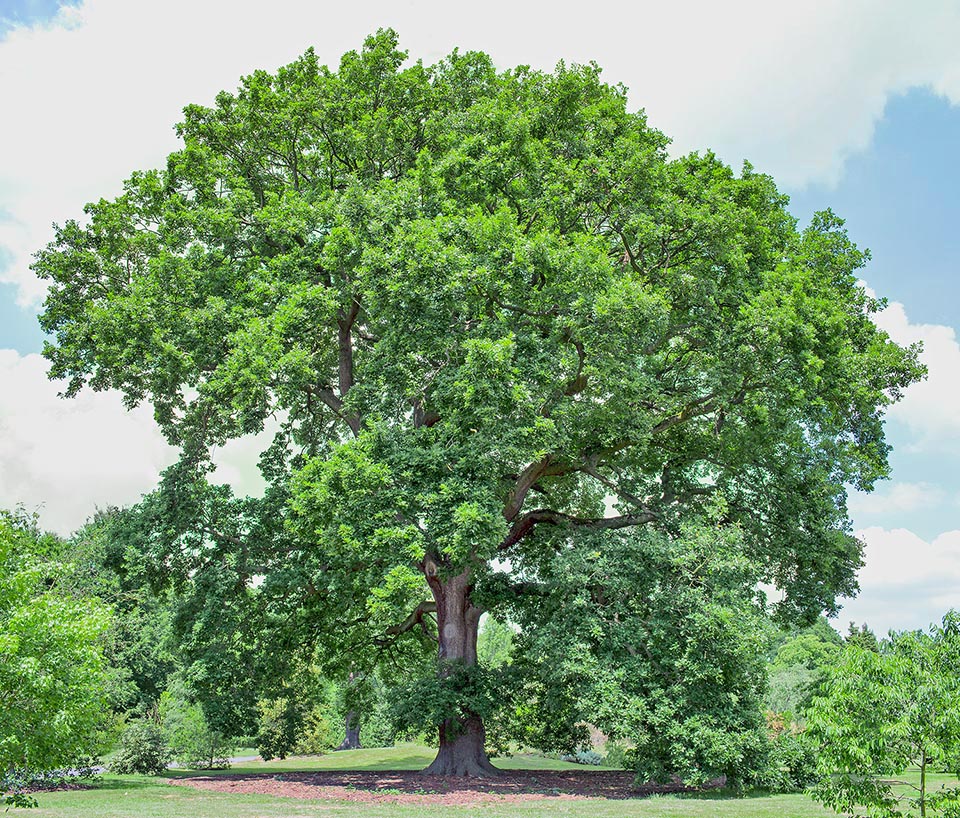
Habit of an isolated sessile oak (Quercus petraea) This species is widespread in much Western and Central Europe, and it can exceed the 40 m of height © Giuseppe Mazza
They are subdivided in the two subgenera Quercus and Cerris; the first is divided in 5 sections: Quercus (northern hemisphere), Ponticae (only two species, one Caucasian and the other of California), Protobalanus, Virentes and Lobatae (from northern America to Colombia); the second is distinguishing in three sections: Cerris and Ilex (Eurasia and North Africa) and Cyclobalanopsis (tropical and subtropical Asia).
The Sessile oak, Quercus petraea (Matt.) Liebl. (the specific epithet ‘petraea’ means “of rocky places” and it refers to its presumed preference, but in reality quite occasional, for clearly stony and well-drained environments), is called, in French “chêne rouvre” or “chêne sessile”, in English, “sessile oak” or “durmast oak”, in Italian, “rovere”, in German, “Winter Eiche”, in Spanish, “roble abar” or “roble del invierno”. It is a long-lived and large tree that may reach the 30-40 (50) m of height with diameters of 1-2 m; the trunk is cylindrical, straight, and, unlike that of the more heliophilous English oak, long undivided; the rhytidome, grey and smooth up to about 20 years , then splits in long and regular longitudinal furrows that define ribs having a tendentially rectangular section.
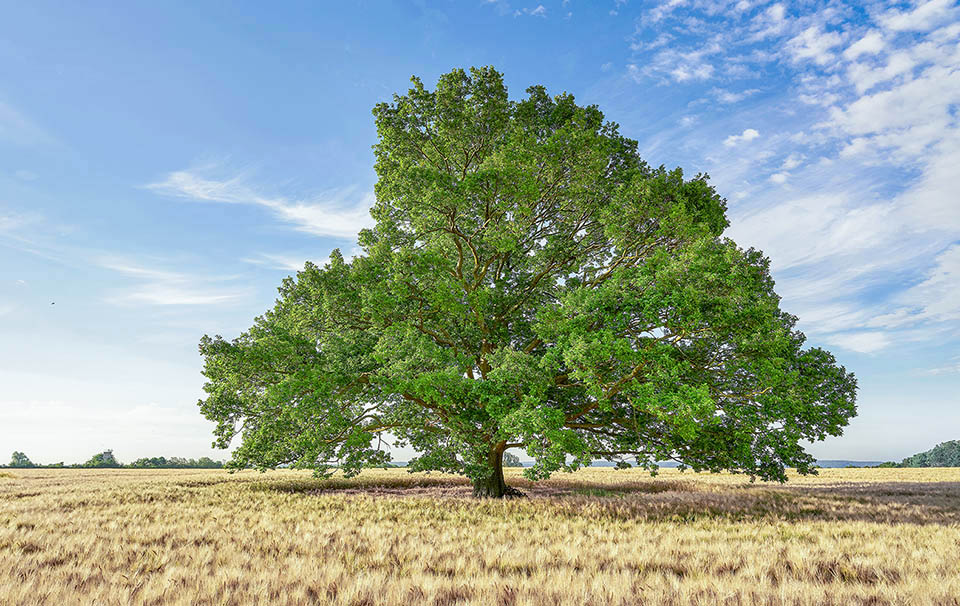
Among European agricultural landscapes it is not uncommon to meet an isolated tree like this sessile oak, with a very ample crown, in the middle of a large lawn or, more easily, of a field, like this wheat field, to provide the cattle and the shepherd with a refreshing break in its shadow in the hottest hours of the summer days © Joachim Boldt
The crown is ample, dense and fairly regular also for the arrangement of the main branches that are rather straight; twigs are grey-brown, glabrous and with leaves slightly coriaceous of intense green colour and glabrous on the upper pagina, whilst the lower one is glaucescent with a slight pubescence along the secondary veins. The leaf blade, 8-12 (14) cm long and 5-7 (10) cm broad, is oblong-obovate with the maximum width towards the middle, and more or less cuneate at the base and it has 5-8 pairs of rounded lobes, the petiole is typically long varying from 15 to 25 (30) mm. There are both sun and shade leaves, the first ones are thicker. Like in downy oak, also in sessile oak the twigs of the young plants or the juvenile (epicormic) shoots of the adult ones retain their leaves marcescent, dead and dry, through the winter.
In the root system the taproot remains active for a long time producing long and robust lateral roots that descend diagonally into the ground. The wood is ring-porous, discolored with white-yellowish sapwood and light brown heartwood that, with age, darkens. The rays are mostly uniseriate but there are also several multiseriate rays (about 5% of the total), wide and easily visible.
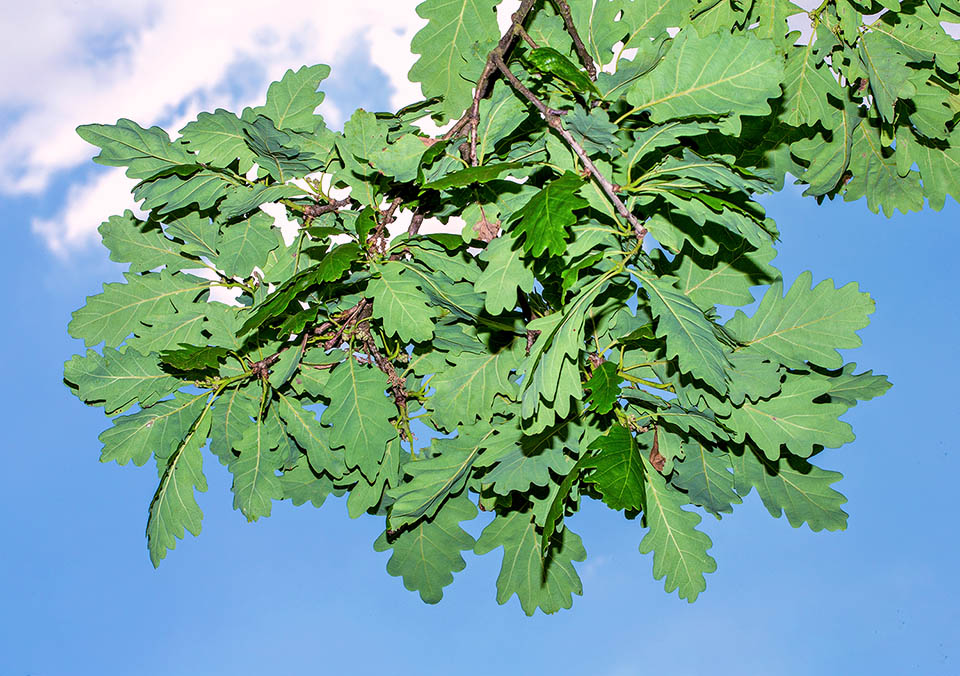
Mostly in the first months after sprouting, the sessile oaks leaves have a much lighter and glaucescent underside © Giuseppe Mazza
The staminate flowers, each with 6 stamens, are arranged closely in pauciflor pendulous catkins 3-6 cm long; the pistillate ones, practically stalkless, are borne in clusters of 2-5 on short spikes that arise from axils of the petioles in the apical portion of the current year twig; they have 3 styles each. To highlight the extreme reduction of the pistillate flower stalks, synonyms of Q. petraea no longer used are Q. sessilis Ehrh. and Q. sessiliflora Salisb. Flowering occurs at the same time as foliation.
The fruit ripens in the year; it is 2-3 cm long and is included for 1/4-1/3 in a cupule formed by pubescent scales, 1 2 mm long and tightly appressed. The integument (pericarp) is smooth, brown-olive, not striated and while drying up becomes tawny. As in all oaks, germination is hypogeal and the seed is not dormant therefore the acorn either germinates quickly (at times the emission of the rootlet happens when the acorn is still on the tree), or dies. During the very first years of life of the plant the leaves may remain green throughout the winter.
Q. petraea has a distribution range extending on most western and central Europe, reaching, east, an imaginary line connecting Gdansk with the Danube delta whilst, west, it includes the British islands, France and northern Spain.
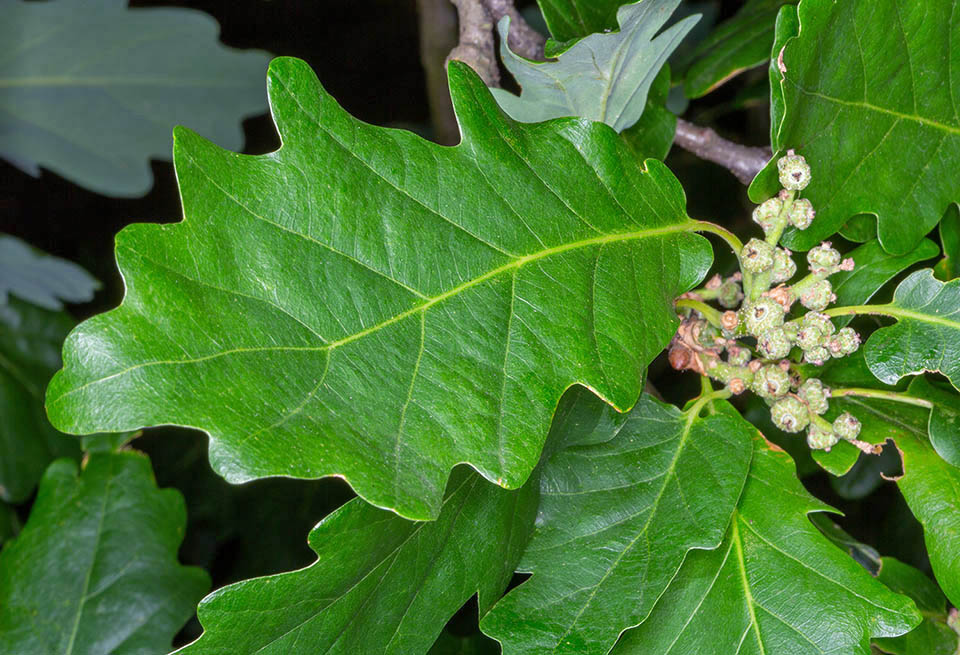
Glabrous leaves and very young growing acorns. Quercus petraea distinguishes from Quercus robur by the longer petiole and by leaf cuneate at the base and in the middle © Giuseppe Mazza
Northwards, the sessile oak reaches Jutland and the southern part of the Scandinavian peninsula whilst southwards it lives in the pre-alpine zone and along the Italian peninsula up to Sicily, in Corsica and in almost all the Balkan peninsula up to Greece where its presence becomes more sporadic. Then, through Anatolia, it reaches the Caucasus and the mountains of southern Turkey. In many regions sessile oak has undergone over the centuries an intense exploitation to obtain timber as well as to replace the forests with other crops; for these reasons in Mediterranean basin woods with sessile oak have largely disappeared (well highlighted, for example, by the numerous toponyms scattered in the Italian peninsula) but single specimens or in small groups are found, albeit not frequently, in the mixed deciduous not thermophilic broad-leaved
Conversely, in Central Europe and especially in the Atlantic regions, Q. petraea is still quite widespread and cultivated and forms woods either on acidic and humid soils (together with the silver birch, Betula pendula Roth) or, when they approach neutrality, with several other deciduous broad-leaved trees that, depending on the environments, can be common beech (Fagus sylvatica L.), European hornbeam (Carpinus betulus L.), wild cherry (Prunus avium L.), various maple trees (Acer pseudoplatanus L., A. campestre L. and A. platanoides L.), lindens (Tilia platyphyllos Scop., T. cordata Mill. and their natural hybrid), rowan and whitebeam (Sorbus aucuparia and S. aria (L.) Crantz) and, in the most humid soils the ash (Fraxinus excelsior L.) and the English oak (Quercus robur L.).
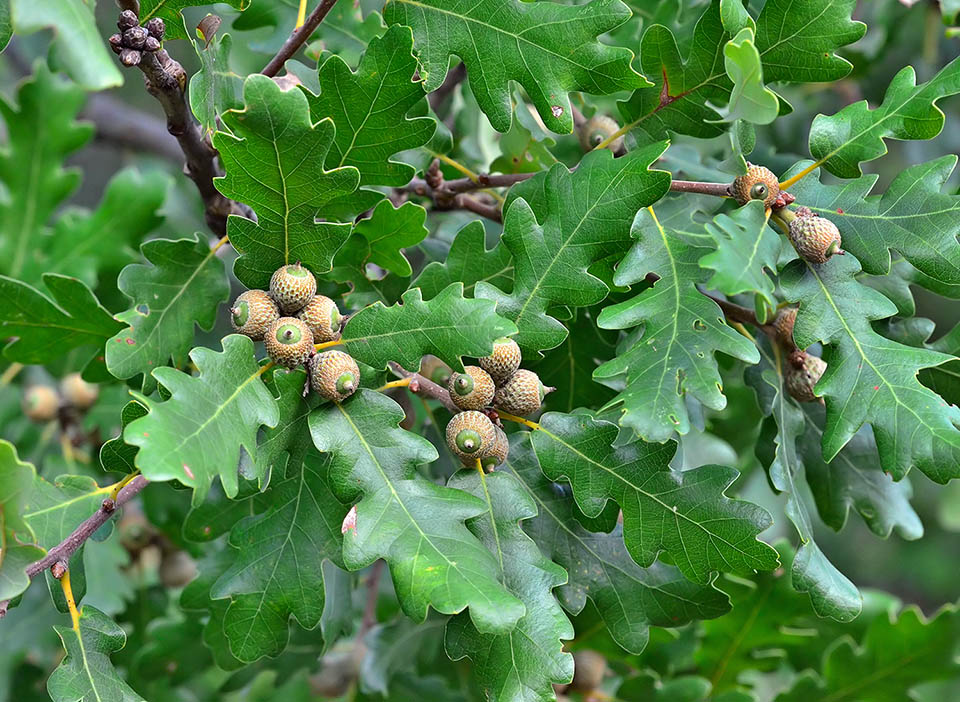
Glabrous leaves and very young growing acorns. Quercus petraea distinguishes from Quercus robur by the longer petiole and by leaf cuneate at the base and in the middle © Giuseppe Mazza
Although preferring moderately to acidic soils, the sessile oak can grow also on calcareous soils as long as they are well drained specially, where the water may only be lacking for a short time: it is an oceanic species and prefers temperate environments not particularly cold in winter but not too hot and dry in summer and it always requires atmospheric humidity in summer as well as in winter.
It is very susceptible to spring frosts as it sprouts quite early (approximately 10-15 days before the English oak even if the time interval becomes shorter at northernmost latitudes). It is not strictly heliophilous and the young plants may tolerate continuous, but non intense shading for 2-3 years. Compared to beech, the sessile oak is more sensitive to the low temperatures and is less shade-tolerant but bears drought better; compared to the English oak it is more rustic as it accepts acidic soils as well as calcareous, it resists much better to drought and, being less demanding in light, it tolerates competition better.
The sessile oak is very long-lived and there are several hundred-year-old specimens; when young it is fast- growing that over time tends to slow down. Its wood is heavy, strong and durable; it is very similar to that of the English oak and it is too to sought after for its multiple uses in carpentry and in the naval and civil constructions; it is utilized for floor boards, for plywood, for veneerings: it serves as firewood and as charcoal.
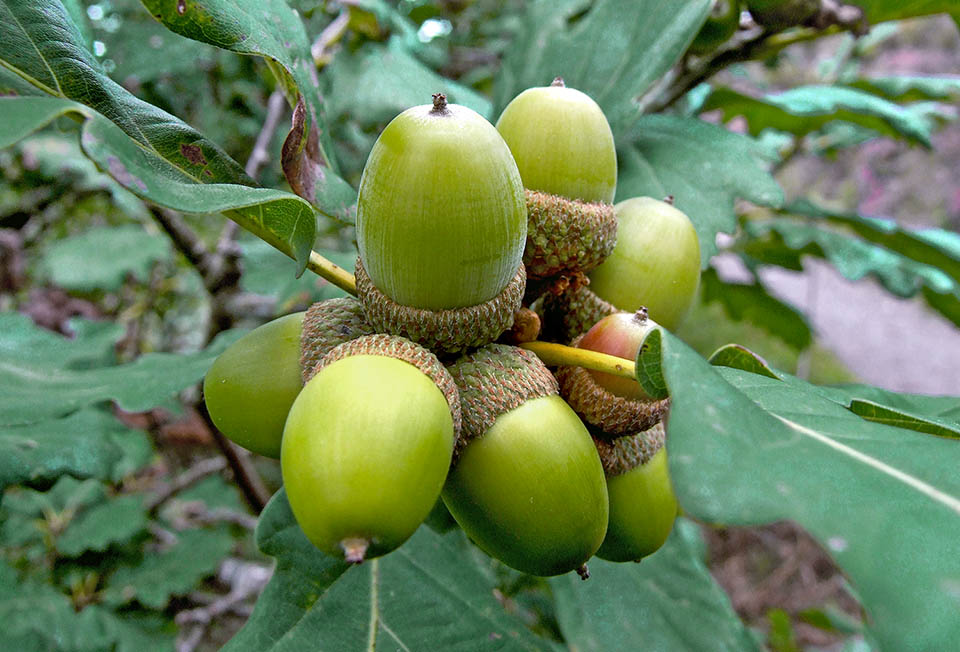
The 2-3 cm long fruit, is included per 1/4-1/3 into the cupule formed by tiny pubescent scales, 1-2 mm long and tightly appressed © Philip Goddard
Like that of English oak, its wood is sought after for manufacturing barrels staves (barriques) to improving the aging of wines and spirits and in France they are carrying on studies to identify the populations with the most suitable tannic contents; the “tannin” is also abundant in the bark and in the leaves. Acorns are popular with wildlife and high forests serve often for grazing especially for pigs.
Thanks to its elegant and majestic, for many centuries the sessile oak has assumed symbolic value and has often been adopted in heraldry, where it is represented with crossed branches, but above all this tree is employed isolated or in groups in ornamental greenery often planting selected varieties.
Generally, it has a good resistance to harmful influences (such as disease and climatic and meteoric extremes), parasites are the same of the other Eurasian oaks of the same section; they are cerambycidae, defoliating moths such as Tortrix viridana, Lymantria dispar and Thaumetopoea processionea, fungi causing the powdery mildew (Erysiphe alphitoides), fungi of wood decay and, above all, of root rot such as Daedalea quercina, Armillaria mellea, Inonotus dryadaeus, Ganoderma sp.pl. and so on, and canker-causing agents such as Biscogniauxia mediterranea. Ceratocystis fagacearum (= Bretziella fagacearum) is the fungus that causes the ‘oak wilt’, a tracheomycosis absent in Europe and currently restricted to the Central and Eastern USA where it constitutes for the oaks the most dangerous pathology because it rapidly causes the death of trees. Unfurtunately, European deciduous oaks have been shown to be very sensitive to this pathogen in laboratory tests.
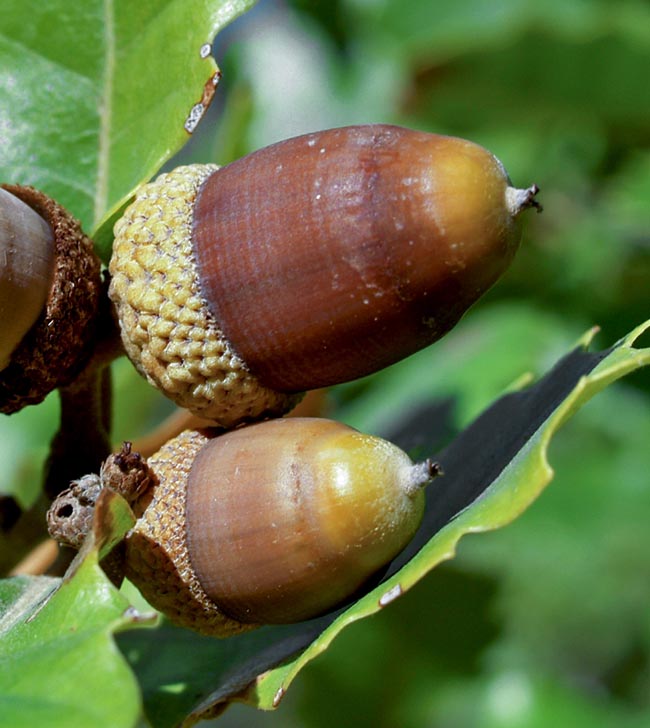
The acorn ripens in the year. Its integument is smooth, brown-olive, not striated and drying gets tawny. The seed is not dormant and the germinating radicle can even emerge on the tree, before fruit falls on ground © Ferran Turmo
A pathology that is proving very dangerous also in Europe is the so-called «Sudden Oak Death» or SOD for which the oomycete Phytophthora ramorum, together with various bacteria, is considered the primary agent and to which perhaps participates as vector a buprestid beetle, Agrilus biguttatus; especially the trees over fifty years old are affected and die within 4-6 years. Less serious, or rather, with a longer course, is the so-called COD («Chronic Oak Decline») that consists of a pathological syndrome in which participate several microorganisms, among which the aforementioned oomycete, and that in more or less long times causes a severe decay of the tree.
More or less abnormal outgrowths, even numerous, frequently, may be visible which have nothing to do with the normal organs of plants of this species: they are galls caused by the oviposition by some Cynipidae (Hymenoptera).
The oviposition gall (or cecidium) is an outgrowth of shape and size that vary not only depending on the organisms that cause them (viruses, bacteria, fungi, nematodes, insects and mites) but also in the plant species that undergo them and is due to an uncontrolled tumor-like proliferationof the cells involved.
On the woody plants, among the best known galls, on the leaves of terebinth stand those, very showy, in the shape of goat horns caused by some aphids and the small ones, conical or ovoidal, on the leaves of beeches (Mikiola fagi) or cylindrical on those of lindens caused by a mite (Eriophyes tiliae); but surely better known are those caused by some small wasps of the family Cynipidae (Hymenoptera) on roses (Diplolepis rosae), on oaks and, recently in Europe, on chestnut tree (Dryocosmus kuriphilus).
Usually, the egg deposition in the tissues of a plant causes a hyperplastic and hypertrophic reaction of the affected tissue which produces a pseudo-organ with a characteristic and constant shape in the affected plant without however compromising the regular functionality of physiological processes of the plant. However the chestnut gall wasp (Dryocosmus kuriphilus) is an exception because it causes the abscission of the leaves and in the meantime it compromises the production of the fruits whereby attacks intense and repeated for several years lead to the death of the plant.
On oaks the galls can be formed not only on the twigs and leaves but also on the reproductive organs (catkins and young acorns); the shapes and the dimensions of the galls that can be observed are several: from few millimeters to 3-5 (6) cm in diameter, globose, ovate or discoidal, gem-shaped, pincushion-like, sea urchin- or starfish-shaped, smooth, tuberculate, multilobed or, ‘hairy’ because covered by numerous filaments, etc.
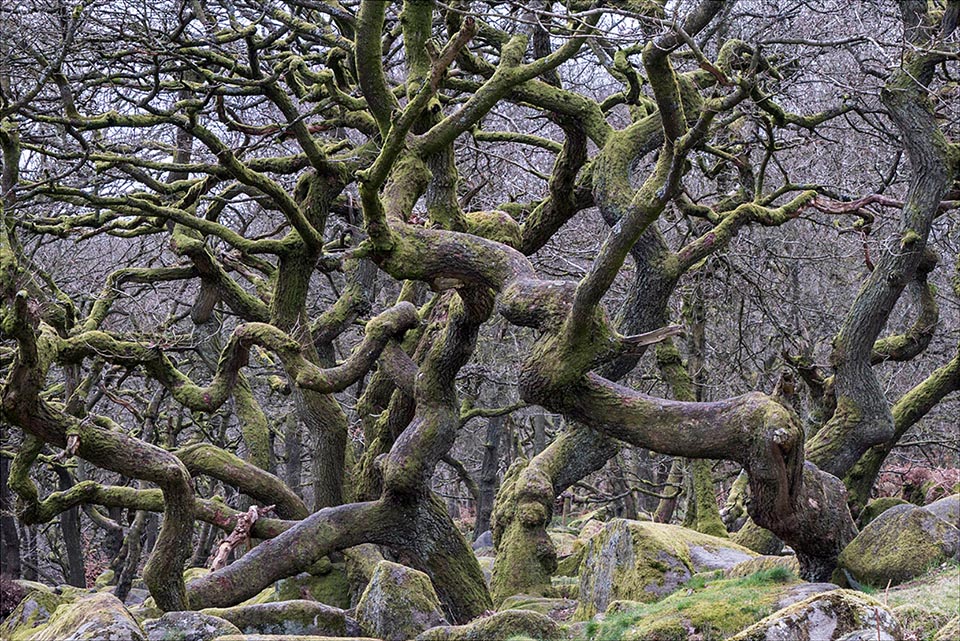
Winter aspect of the an oak grove with twisted trunks at Padley Gorge in England. External factors like now and especially wind, can modify the architecture of sessile oaks © Neil Shaw
The colours also vary from brown to red, green, yellow and orange and blue but, always, these characters are constant for each species of parasite depending on oak species.
As previously mentioned, the galls do not cause particular damages to the host, but, by sure, they can determine unpleasant aesthetic effects. They are very rich in gallic acid, free as well as combined in the form of glucoside or of tannin. For this reason, oak galls have always had an important role both for the tanning of hides and also for the production of inks (iron gall ink), which in aqueous solution oxidizes rapidly, if treated with ferrous sulphate it becomes a salt (iron gallate) that can be used as a stable blue-. This type of ink has been universally employed until the end of the XIX century when the India inks took over to then become, they too, obsolete with the affirmation of ballpoint pens.
It has not been clarified exactly what are the roles of the two organisms in the formation of the galls: certainly the saliva of the insect is responsible for activating the biochemical and morphogenetic responses of the plant tissues, probably participating even directly in them, but it is not clear if whether the components of the saliva interfere with biochemical processes inhibiting, modifying or accelerating some of them (‘hormonal’ function), or if, instead, they interfere with the DNA of the host inducing or inhibiting the expression of certain genes. In fact, the same insect determines the development of galls of different shapes on different species. Once waked up the adult (or the adults), the gall becomes a refuge for many other animals living usually on the leaves and twigs of the oaks.
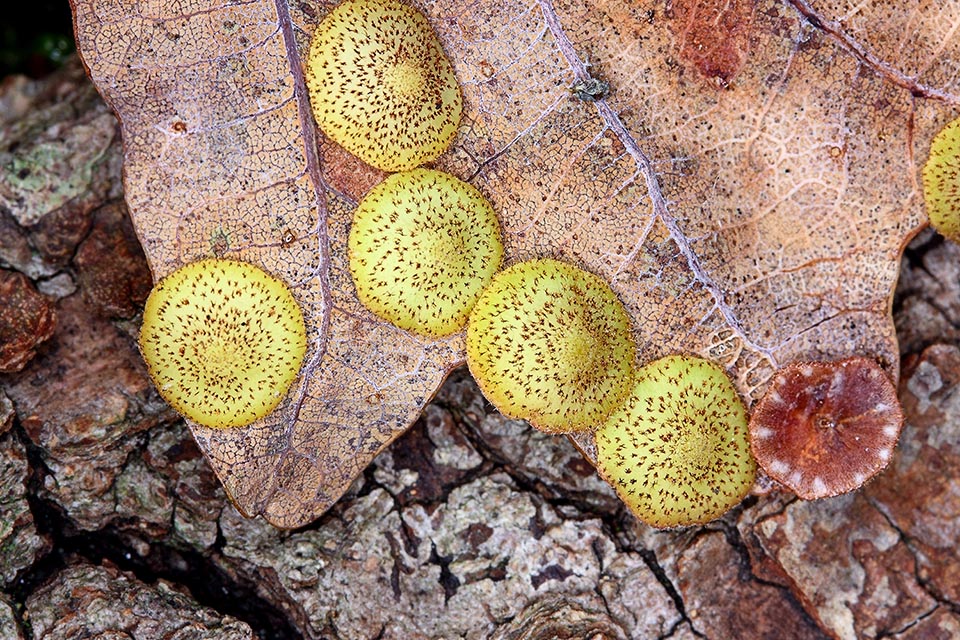
Galls produced by Neuroterus quercusbaccarum, small wasp of Cynipidae family that had laid its eggs in the tissue of this leaf now fallen on the ground © Wibe-Jan Postma
According to the IUCN (International Union for Conservation of Nature) sessile oak is a species at low risk of extinction (LC, Least Concern) but in many regions, especially of the Mediterranean and of the Balkan Peninsula, the intense cuts to obtain a very remarkable timber and the changes of use of those woodlands, especially for transforming them in agricultural cultivations or in pastures but also for wood productions with other species much shorter in cycle length, has more or less drastically influenced its number.
The oaks, evergreen like the holm oak or deciduous like most of the other species, have always aroused awe and reverence in the ancient populations of Europe, not only for the size and age they could reach but especially for the central role they had in the life of the forest; sacred oaks and the related sanctuaries were widespread throughout Europe even if, for obvious reasons, in most cases we cannot identify exactly which oak species were of reference.
These feelings of reverence, but also of admiration if not of veneration, have continued to be expressed up to the present day: in 1861 Anthony Trollope, one of the most famous English writers of the Victorian Age, in one of his volumes of the “Chronicles of Barsetshire” had written «The Chace of Chaldicotes – the greater part of it, at least – is, as all the world knows, Crown property, and now, in these utilitarian days, is to be disforested […] People still come from afar to see the oaks of Chaldicotes, and to hear their feet rustle among the thick autumn leaves’.
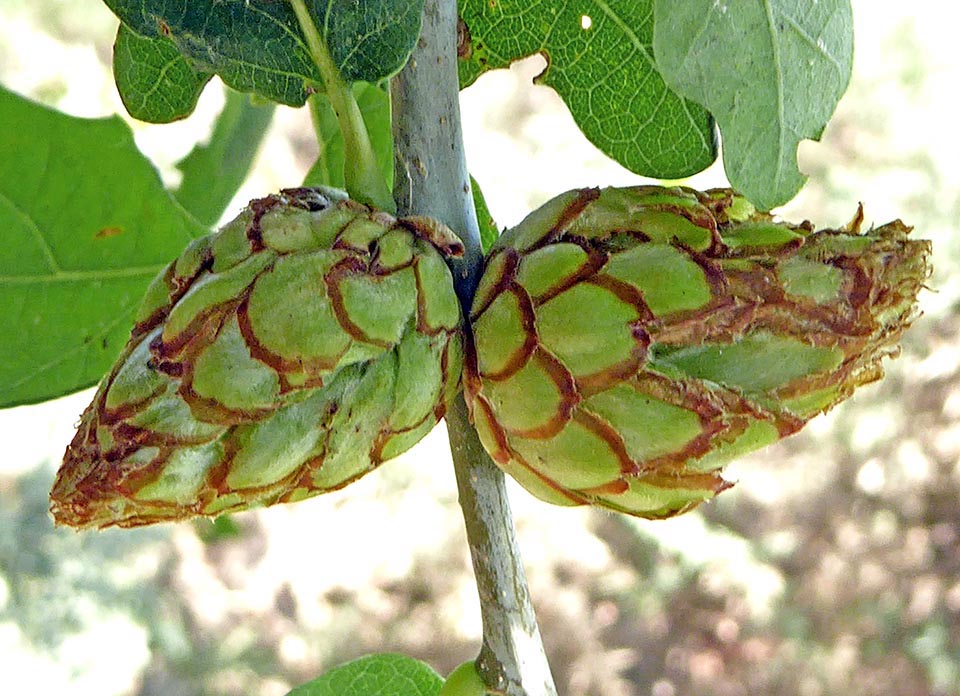
Here two gem-like galls produced on a twig by another Cynipidae, Andricus foecundatrix © Sally Jennings
But they will soon come no longer. The giants of past ages are to give way to wheat and turnips; a ruthless Chancellor of the Exchequer, disregarding old associations and rural beauty, requires money returns from the lands; and the Chace of Chaldicotes is to vanish from the earth’s surface.» (A. Trollope – Framley Parsonage. ch. III. Smith, Elder & Co. 1861).
The species is subdivided in three subspecies: subsp. petraea (widespread throughout the range), subsp. iberica (Steven ex M.Bieb.) Krassiln. (= Q. polycarpa = Q. dshorochensis = Q. iberica) living in the Balkans and in Anatolia and subsp. pinnatiloba (K.Koch) Menitsky, exclusive of Anatolia. It is mostly questioned the validity of the subsp. huguetiana Franco & G.Lopez, which grows in France and in Spain.
The sessile oak, together with the English oak (Q. robur), the downy oak (Q. pubescens Willd.), the Hungarian oak (Q. frainetto Ten.) and the Pyrenean oak (Q. pyrenaica Willd.), belongs to the sect. Quercus of subgen. Quercus.
At first glance these four oaks, commonly called ‘white oaks’, are easily confused with each other but there are some morphological characters that can help in their identification. Sessile oak and English oak distinguish from each other by the shape of the leaf as the first has a 15 to 30 mm long petiole, the cuneate base and is wider in the central part whilst the second has the petiole very short (up to 4-5 mm), the base has two small lobes and it is ampler in the apical part and, especially, because the sessile oak has practically sessile acorns whilst those of the English oak have 3 to 12 cm long peduncles.
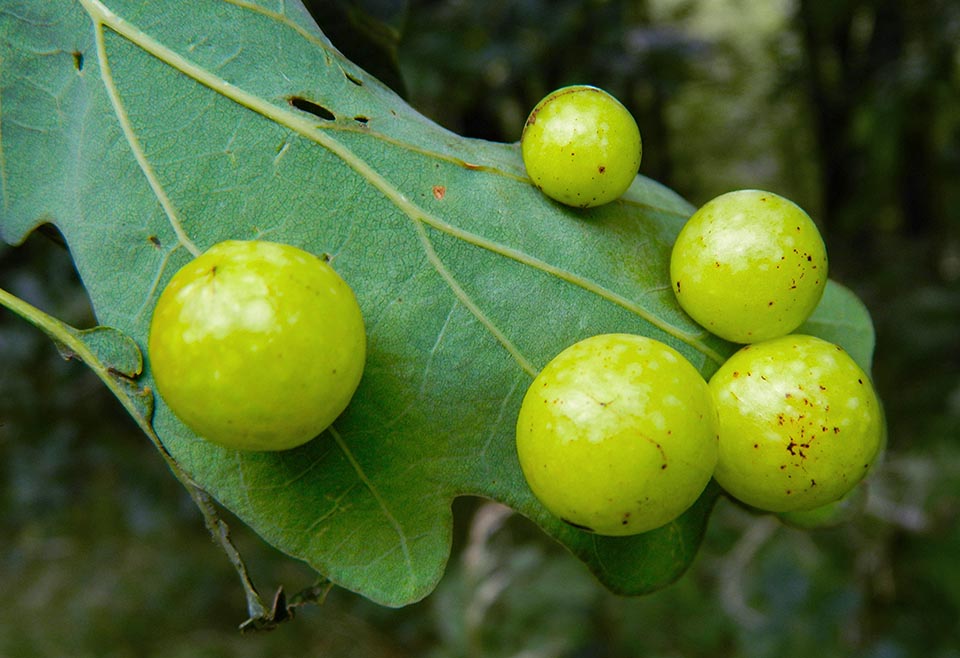
As the name states, Cynips quercusfolii affects the leaves of many species of oaks causing characteristic roundish galls © Sally Jennings
Sessile oak and downy oak are easily differentiate because the first has glabrous twigs with hairless or just ciliate buds and the leaves glabrous with barely veins whilst the downy oak has densely tomentose twigs with pubescent buds and thickly pubescent leaves (when sprouting they often appear white); also the Pyrenean oak has the twig thickly tomentose and pubescent leaves that, however, when sprouting, do appear pinkish.
However, to complicate the identification, it is the fact that these species hybridize quite easily with each other so that are frequent specimens with “mixed” characters such as, for instance, Q. ×rosacea (with the English oak), Q. ×streimii (with the downy oak), Q. ×thellungii (with downy oak and English oak), Q. ×cantabrica (with Pyrenean oak and English oak) and Q. ×trabutii (with the Pyrenean oak) and in many specimens the most typical physiognomic characters are ‘diluted’ due to the introgressive crossings that can occur.
The morphological affinities with other species and the several different intermediate forms have led to naming this species in different ways, names that have now all been discarded. About this, ‘The Plant List’, besides the two already mentioned (Q. sessilis Ehrh. and Q. sessiliflora Salisb.) reports other 102 synonyms, depending on the cases, used for the rank of species, subspecies or varieties.
→ To appreciate the biodiversity within the FAGACEAE family please click here.
